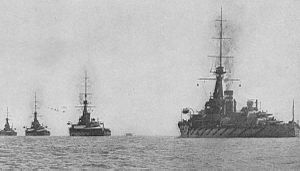Squadron (naval) facts for kids
A squadron is a group of warships. It's bigger than a flotilla but usually smaller than a full fleet. Think of it as a medium-sized team of ships. The exact size of a squadron can be very different depending on the country and the time period.
For example, before 1864, the entire Royal Navy (Britain's navy) was split into three huge squadrons: the red, white, and blue. Each of these was more powerful than most other countries' entire navies! Today, a squadron might have three to ten ships. These ships could be large warships, transport ships, submarines, or smaller boats. They often work together as part of a bigger task force or fleet.
A squadron can be made up of just one type of ship, or many different types. They might have a special job, like protecting the coast, blocking enemy ports, or clearing mines. In the United States Navy, the word "squadron" is often used for groups of destroyers and submarines.
Contents
Who Leads a Squadron?
A large fleet is usually led by a high-ranking officer like a vice admiral or a rear admiral. Squadrons, however, might be led by a commodore. Sometimes, the most senior captain in the group takes charge. This depends on how important the squadron's mission is.
If a squadron is very large, it might be divided into smaller groups called divisions. Each division would then be led by a captain. Like a fleet, a squadron is usually a permanent group of ships. This means they train and work together regularly.
Types of Squadrons
Squadrons can be used in different ways:
Independent Squadrons
These are groups of ships that are too small to be called a full fleet, but they work on their own. They might be named after a specific ocean or sea where they operate. The admiral leading this squadron might be the main naval commander in that area. An example is the US Navy's Asiatic Squadron. This group was stationed in China between 1868 and 1902.
Temporary Fleet Divisions
In the past, during the Age of Sail (when ships used sails), large fleets were often divided into three parts: the front (van), middle (centre), and back (rear) squadrons. These names came from where they lined up during a battle. If a few ships were temporarily sent away from the main fleet for a special job, they would also be called a squadron.
Permanent Battle Formations
As warships became more advanced in the 1800s, larger ships started to form permanent, numbered squadrons. These squadrons were often made up of the same type of warship. An example is the 5th Battle Squadron of the Royal Navy's Grand Fleet.

The U.S. Navy has had many types of permanent squadrons. These include Battleship Squadrons, Cruiser Squadrons (CruRons), Destroyer Squadrons (DesRons), and Submarine Squadrons (SubRons).
In modern navies, squadrons are often more about how ships are organized than how they fight. During the Second World War, navies started to use squadrons less for actual fighting formations. Instead, they began to create carrier battle groups or special task forces. These groups included different types of ships, like capital ships (big warships), destroyers for protection, and aircraft carriers for air cover. They were put together based on what ships were available for a specific mission.
As warships have grown bigger, the word "squadron" has slowly replaced "flotilla" for groups of destroyers, frigates, and submarines in many navies around the world.
See also
 In Spanish: Escuadra naval para niños
In Spanish: Escuadra naval para niños
- Division (naval)


